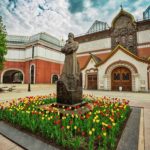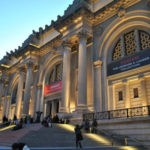Luxor Temple of Amun Ra
 Luxor – formerly the city of Thebes – one of the largest historical cities in Egypt. Today it can be called an open-air museum – there are so many historical places there that hundreds of tourists visit every day. One of the largest structures that can be seen there is the Luxor and Karnak temples dedicated to Amon Ra, Mut and Khons – Egyptian deities. Once these two magnificent temples were a single complex connected by a gallery.
Luxor – formerly the city of Thebes – one of the largest historical cities in Egypt. Today it can be called an open-air museum – there are so many historical places there that hundreds of tourists visit every day. One of the largest structures that can be seen there is the Luxor and Karnak temples dedicated to Amon Ra, Mut and Khons – Egyptian deities. Once these two magnificent temples were a single complex connected by a gallery.
But now the gallery is destroyed and in its place there are urban buildings. Despite this, the temple of Amon Ra has not lost its majesty and grandeur and continues to shock travelers with its unique grace.
The Luxor Temple is currently under excavation. Until the 19th century, a historical monument was buried under a layer of sand. In the end, a Muslim mosque was built over it, which, despite the excavation process, has been preserved and is part of the historical complex. The temple building is not just huge – its columns reach a height of 70 meters, and an entire village was previously located inside.
Architects and scientists devote years to restoring the magnificent building, as well as the alley connecting the two temples – Luxor and Karnak. The avenue of sphinxes reaches 2 kilometers in length and at present its most part has already been restored.
In addition, a historical museum has been built on the territory of Luxor, overlooking the Nile, which includes some statues that previously belonged to the temple. They were found already at the end of the 20th century, and quite by accident – their cleaner found out, sweeping the yard. Archaeologists have confirmed that the statues – small, about the size of a man – are most directly related to the Luxor Temple. Apparently, they were sent to the cache by priests who feared foreign invaders.
The history of the temple of Amon Ra began with a small sanctuary, which was built on the banks of the Nile by Queen Hatshepsut and Thutmose III in the 16th century BC. The sanctuary served as a haven for the sacred rooks that carried statues of deities. Such processions took place annually during the festival of Opet. The sanctuary acquired majestic forms only two hundred years later under the leadership of Amenhotep the third, whose architect was also Amenhotep, son of Hapu. It was he who introduced the temple to the inhabitants with an entrance colonnade, the pillars of which were made in the form of papyrus bundles. Passing through the lobby, visitors entered a spacious courtyard surrounded by porticoes whose columns depicted reed bundles – this plant was considered heraldic in Egypt. Before entering the sanctuary, Amenhotep built several places of worship, as custom required.
In the northern part of the courtyard there is another colonnade, in which tourists are met by petrified stems of papyrus, at the very top of which are blooming flowers. The height of the columns is more than twenty meters. Unfortunately, the walls of the magnificent colonnade have survived only by a third, but you can still see the reliefs describing the celebration of the Opet festival dedicated to Amon Ra. In the center of the images are the sacred boats of the gods, accompanied by priests, people having fun on the occasion, and, of course, the pharaoh himself. As the greatest sage and talented architect, Amenhotep, son of Hapu, was deified during his lifetime and enjoyed recognition and glory. Three of his statues, preserved to this day, are carved with stories telling about his life.
The new pharaoh, Ramses II added another pylon to the temple complex with a large courtyard, around which 74 columns are located. The pylon was decorated with bas-reliefs depicting scenes of the campaigns of the pharaoh against the Hittites. Between the columns, the pharaoh ordered to put up majestic statues depicting Ramses himself, as well as his wife. In addition, four more statues of Ramses II and two magnificent statues are installed in front of the pylon, one of which is now located in Paris on Place de la Concorde. It was from the pylon of Ramses II that the alley called the “Sphinx Alley” began, which, bifurcating, led the traveler to the Mut Temple, as well as to the Khonsu Temple. As a result, all three temples looked like a common complex, striking in its grandeur. All of them, connecting the alleys with the stone sphinxes, have made and still make an unforgettable impression on tourists and travelers.
Even Alexander the Great left his mark on the history of the Luxor Temple – in honor of him, a granite temple was attached to the back of the building. The Christian era made its own adjustments – at this time the hypostyle hall of the temple served as the Christian church, and it remained for some time after.
Even in the vicinity of the modern urban infrastructure that surrounds the Luxor Temple, it does not become less attractive to visitors. In the evening, the temple is effectively illuminated, which only adds to it mystical mystery.



























